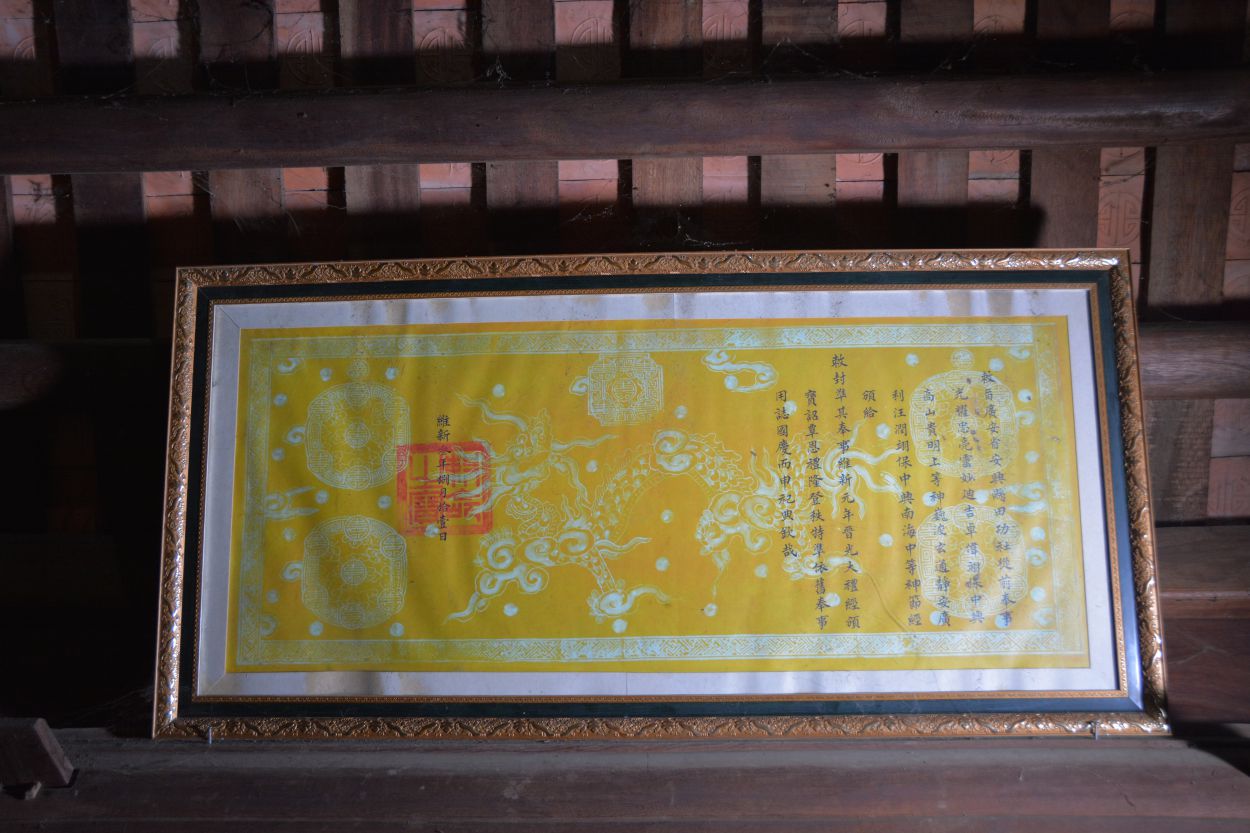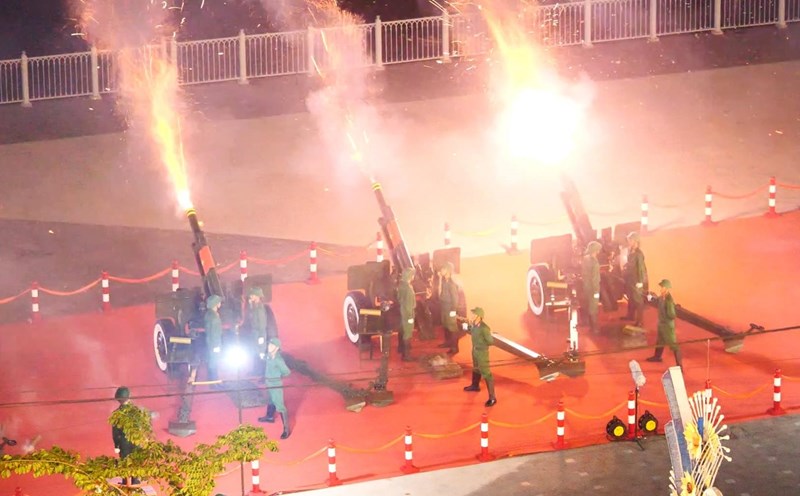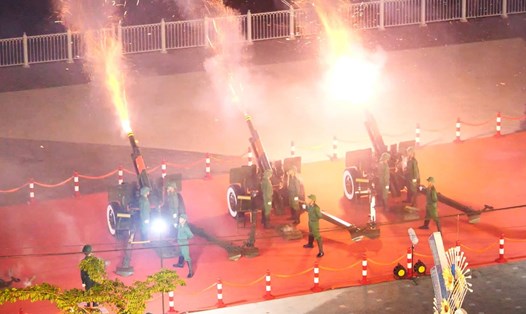Legend of the name "den Cong"
On the side of the historic Bach Dang River, where the nation's glorious feats against foreign invaders were witnessed three times, there is an ancient communal house named Dinh Den Cong. Located in Den Cong 2 area, Trung Vuong ward, Quang Ninh province, the communal house is an important spiritual and historical highlight of Bach Dang Historical Relic Cluster. With its great values, the Cong Communal House was recognized as a National Historical and Cultural Relic in 2000 and then, in 2013, was recognized as a Special National Monument in the entire relic area. The communal house is not only the pride of the Uong Bi people but also a "red address" for educating the tradition of patriotism for generations.
The history of the Dinh Den Cong is associated with the resounding victory of Bach Dang in 1288. The name of the communal house carries a meaningful story of gratitude. According to the precious cities and festivals that are still preserved, this land was formerly called Dien Cong village. In the third resistance war against the Nguyen - Mongolian army, when preparing for the strategic battle on the Bach Dang River, the Hung Dao Institutional Army National Guard of King Tran Quoc Tuan was warned by 4 gods.
Those gods are Cao Son Quy Minh, Nam Hai Ton Than, Phi Bong Tuong Quan and Bach Thach Tuong Quan (The court of the court recorded that Cao Son and Quy Minh were one, so they were also called the Four Generals). The monks assigned Tran Hung Dao a high cage of land with an ancient dai tree, a strategic location to set up an observation post and issue a signal to the entire army to attack and sink the army's boat company in the pre-arranged deposits.
After the great victory, to express gratitude for the support of the gods, Tran Hung Dao prepared a solemn offering to offer a weight. In front of the three soldiers, he exclaimed: "Thanks to the four gods: Cao Son Quy Minh, Nam Hai Ton, Phi Bong General and Bach Thach General am Thuong for helping Hung Dao, I would like to express my gratitude in the two words D'N CONG". From there, he changed the name of Dien Cong village to Den Cong, meaning a place to "repay merits".
To commemorate the merits of the marine general and the gods who helped the people and saved the country, the local people built a temple to worship the four generals, called Mieu Cu Linh (or Mieu Cay Gieng), and built a temple to Tran Hung Dao right on the sacred land. Later, Tran Hung Dao was raised by the people to the title of Thanh Hoang of the village, the Supreme God who sponsored the community, with the title of Venerable.

A cluster of relics of special value
The Cong Temple does not exist as an independent entity but is located in a close religious and historical architectural complex, expressing the typical cultural intersection of the Vietnamese people. Located about 1km southwest of the communal house, Cu Linh Temple was built in the early 14th century to worship the Four General's. In 1954, a major flood caused by rising sea levels severely damaged the temple. To protect the precious heritages, the people have brought all the worship items and props from the temple to the communal house at the Cong Temple Communal House. This " Dinh - Mieu" relationship shows flexibility in religious activities and awareness of heritage conservation of the community. It was not until 2014 that Cu Linh Temple was started for restoration and in 2017 that it was completed as spacious as it is today.
Located right on the left side of the communal house is Long Khanh Pagoda, a Buddha worship facility with a long history. The adjacent " Dinh - Phap" arrangement reflects the philosophy of harmony of the three teachings (Buddha - Lao - Nho) and folk beliefs of the Vietnamese people, where the gate of the seven pillars of the Buddha goes hand in hand with the worship space of national heroes, creating a diverse spiritual center for the people.
After many ups and downs of time and many renovations, Cong Communal House today has a spacious and majestic appearance after a major renovation from 2007 - 2010 with a total cost of more than 11 billion VND on an area of 3,000m2. The communal house was built in the traditional architectural style of the letter "ding" (丁), turning to the West. The project consists of three compartments of the front hall (more than 17m long, more than 5m wide) and a compartment of the rear hall (more than 6m long, more than 6m wide). The entire weight-bearing structure system such as columns, beams, and barges are made of precious ironwood. sophisticated construction techniques are shown through 4 sets of "overlapping gongs". The sculptures are full of artistic style during the Nguyen Dynasty, with the headps carved with sophisticated dragon heads, the folds are plain, the handles are soft and carved with graceful flip-flip patterns.
The Cong Temple is a miniature museum that preserves many valuable historical and artistic artifacts, dating from the Nguyen Dynasty to the present. Among them, it is especially worth mentioning: Six royal decrees issued by the Nguyen Dynasty to the gods worshiped at the palace. These are extremely valuable original documents, affirming the legal status and recognition of the feudal dynasties for the royal court. The exquisite wooden sculptures include an ancient hammock door, a dragon courtyard ornament, large-scale statues, gilded lacquered reliefs, and incense burners (incense burners). These artifacts are not only works of art but also an important source of historical data, helping researchers recreate the history and culture of this land.
If architecture and artifacts are the "authentic" part of the relic, the festival is the "soul", making the heritage live forever in the community. Every year, the Dinh Den Cong Festival is solemnly held for 3 days, from the 13th to the 15th of the first lunar month, with the festival on the 14th. The festival is an occasion for people and tourists from all over to remember the merits of Hung Dao Dai Vuong and his gods, and at the same time pray for a year of favorable weather, national peace, and a bumper crop. The ceremony took place solemnly according to traditional rituals. The highlight is the Solemn Rally, a solemn procession bringing statues of Saint Tran, the title and royal decree of the gods around the village. The procession not only shows respect but is also a form of "lighting up" to give lucky money to the whole community. Then there is the village's royal decree ceremony, with elaborate preparations of artifacts and documents. After the solemn ceremony, the festival's bustling and bustling atmosphere with many unique folk games, tightening the village and neighborhood affection such as: Close-watching pig- catching, chicken fighting, swinging, boxing, spursing...
The Cong Temple is a cultural space, where architecture and beliefs blend, and is a place where the patriotism and gratitude of our ancestors are still respected and promoted by today's generations.











